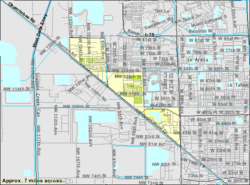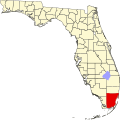Hialeah Gardens, Florida | |
|---|---|
| City of Hialeah Gardens | |
 Palmetto Expressway at night in the direction toward Hialeah Gardens | |
 Location in Miami-Dade County and the state of Florida | |
 U.S. Census Bureau map showing city limits prior to the most recent annexation | |
| Coordinates: 25°52′42.03″N80°20′53.06″W / 25.8783417°N 80.3480722°W | |
| Country | |
| State | |
| County | |
| Incorporated | December 1, 1948 |
| Government | |
| • Type | Council-Mayor |
| • Mayor | Yioset De La Cruz |
| • Chairman | Luciano "Lucky" Garcia |
| • Councilmembers | Jorge Gutierrez, Elmo L. Urra, Vice Chairman Rolando "Roly" Piña, and Finance Chairman Jorge A. Merida |
| • City Manager | Mayor Yioset De La Cruz |
| • City Clerk | Maria L. Joffee |
| Area | |
• Total | 3.67 sq mi (9.51 km2) |
| • Land | 3.22 sq mi (8.34 km2) |
| • Water | 0.45 sq mi (1.16 km2) |
| Elevation | 6.6 ft (2 m) |
| Population | |
• Total | 23,068 |
| • Density | 7,159.53/sq mi (2,764.36/km2) |
| Time zone | UTC-5 (EST) |
| • Summer (DST) | UTC-4 (EDT) |
| ZIP Codes | 33018, 33016 |
| Area codes | 305, 786, 645 |
| FIPS code | 12-30025 [3] |
| GNIS feature ID | 0305060 [4] |
| Website | www |
Hialeah Gardens is a city in Miami-Dade County, Florida, United States. The city is part of the Miami metropolitan area of South Florida. The population was 23,068 at the 2020 US census, [2] up from 21,744 in 2010. The population density is mostly made up of single-story development.


